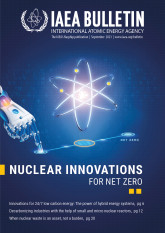
If you would like to learn more about the IAEA’s work, sign up for our weekly updates containing our most important news, multimedia and more.
Harnessing Nuclear Power for Desalination to Secure Freshwater Resources
Omar Yusuf

Nuclear desalination plants, such as the one pictured here at the Karachi Nuclear Power Complex in Pakistan, have been demonstrated as a viable option to meet the growing demand for potable water. (Photo: Pakistan Atomic Energy Commission)
Water sits at the centre of the climate crisis. Rising sea levels, increasingly frequent flooding and droughts, and declining glacial and snow cover are all projected to frustrate access to sources of potable water. Without solutions to mitigate these and other effects of climate change, water scarcity will increasingly pose a threat to quality of life on a global scale. The demand for fresh water for drinking and industrial use is not limited to landlocked countries, but also affects small island developing states and countries with large coastal territories.
As desalination is a very energy intensive technology, it is imperative to power it with large-scale, zero-carbon sources, such as nuclear energy, in order to continue providing essential access to clean water to an increasing number of people worldwide, while simultaneously addressing climate change and commitments to net zero.
Nuclear power plants could offer a solution, while serving a dual purpose: producing low carbon electricity and turning seawater into fresh water. “The non-electric applications powered by nuclear energy, such as desalination, present sustainable solutions for a number of water-intensive endeavours — from the consumption needs of millions of households and the industrial applications of fresh water to agriculture and livestock rearing — that current and future generations will face,” said Francesco Ganda, Technical Lead for Non-Electric Applications at the IAEA.
For nearly 30 years, the IAEA has supported countries’ efforts to improve supply, quality and access to clean water through nuclear desalination, a process that uses the heat and electricity produced by a nuclear power plant to remove salt and minerals from seawater through distillation or membrane separation, mostly reverse osmosis. Desalination using nuclear power is less carbon intensive and is cost competitive with alternative methods, such as fossil fuel-based techniques. India, Japan and Kazakhstan have the most experience in nuclear desalination, with hundreds of reactor-years of successful operations. This solution provides a viable, cost-effective path to potable water for thousands of communities. “Nuclear power plants could help meet the growing demand for potable water and provide hope to areas with acute water shortages in many arid and semi-arid zones,” Ganda added.
In 1996, the IAEA established its first advisory group on nuclear desalination, which helped to stimulate discussion on nuclear desalination activities and provided a forum for countries to exchange their experiences in the application of nuclear power plants to desalinate water. Global interest in seawater desalination using nuclear energy has grown ever since.
“More countries are seriously considering desalination powered by nuclear energy to address their water needs, while avoiding carbon emissions,” Ganda said. “As desalination is a very energy intensive technology, it is imperative to power it with large-scale, zero-carbon sources, such as nuclear energy, in order to continue providing essential access to clean water to an increasing number of people worldwide, while simultaneously addressing climate change and commitments to net zero. The IAEA is at the forefront of efforts to support countries in achieving these goals.”
To foster and accelerate action in this scientific domain, the IAEA has developed and launched two software programs: the Desalination Economic Evaluation Program and the Desalination Thermodynamic Optimization Program. Both are designed to allow experts to conduct economic, thermodynamic and optimization analyses of different power sources when coupled with various desalination procedures.
Realizing the potential of desalination
In 2022, through its technical cooperation programme, the IAEA hosted a national training course in Amman, Jordan, to build capacity in the use of small modular reactors (SMRs) to desalinate water. Through the IAEA Platform on Small Modular Reactors and their Applications, the Jordan Atomic Energy Commission (JAEC) requested a review by IAEA nuclear power experts of a nuclear desalination study that employs SMRs.
“Desalination is considered the primary source of fresh water in Jordan to fulfil the expected demand and reduce the supply-demand deficit,” said Khalid Khasawneh, Commissioner for Nuclear Power Reactors at the JAEC. The study found that using nuclear energy for desalination is feasible in Jordan, and Khasawneh added that “it offers competitive prices for fresh water to end consumers, in comparison with imported energy sources.”
The IAEA will host an interregional training course in Moscow in October 2023 to explore design considerations for cogeneration projects using SMRs and microreactors, where electrical power or heat generation is used to fuel the desalination process.
A series of technical publications designed to introduce experts to the design, economics and safety of seawater desalination using nuclear power complements the analysis software, the IAEA Toolkit on Nuclear Desalination and the training provided by the IAEA. In an effort to drive innovation in this field, the IAEA has also completed a number of coordinated research projects related to desalination.
The IAEA is continuing to organize efforts towards improving how existing and future nuclear reactors can contribute to enhancing access to clean water through decarbonized desalination technologies that use nuclear power. Last year, the IAEA launched a new research project to assess various nuclear cogeneration applications, including nuclear desalination, and to explore why and how countries could consider nuclear cogeneration in their portfolio of options to address the climate challenge.







